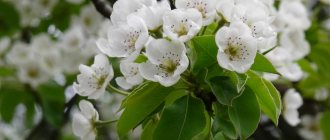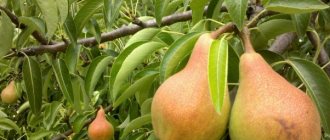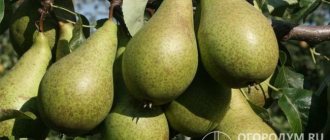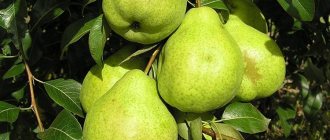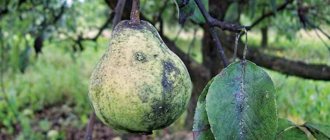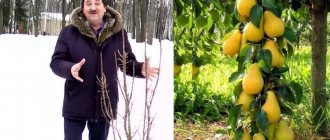Pear Skorospelka from Michurinsk.
Description of the variety
Skorospelka pear from Michurinsk fully lives up to its name. It ripens earlier than all varieties. The summer pear, although small in size, is stable and productive.
Characteristics of wood
The culture has great growth vigor, high with a medium density wide pyramidal crown. The main branches extend from the trunk at an acute angle and are directed upward.
The bark is light brown, flaky. The shoots are straight, the leaves are medium-sized, ovoid with a sharp tip, the flowers are white.
Description of fruits
The pears are small, weighing 70-80 grams, regular in shape, green in color, and when fully ripe they turn light yellow. On the sunny side there may be a faint pink blush.
The pulp is whitish-cream, juicy, aromatic, sweet and sour, practically without granulations.
Pear Michurinskaya Skorospelka.
Characteristics
The early ripening plant from Michurinsk brings a decent harvest of fruits almost every year . It begins to bear fruit in the fifth year of life , increasing its yield with age . Having reached 10 years, trees of this variety are capable of producing up to 100 centners of fruit per hectare.
High-yielding varieties also include pears: Bere Russkaya, Bere Bosk, Tonkovetka, Tatyana and Talgar beauty.
Skorospelka from Michurinsk ripens earlier than all other pear varieties - on the 20th of July, and sometimes 5-6 days earlier. In room conditions, the fruits are stored for about a week , and in the refrigerator - up to 2 weeks.
Skorospelka from Michurinsk is a self-fertile variety ; its yield increases significantly if the pollinating variety “ In Memory of Yakovlev ” grows nearby.
At state tests, Skorospelka from Michurinsk showed itself to be one of the most frost-resistant varieties . When artificially frozen, it adequately withstood even such a low temperature as -40 °C.
Frost-resistant varieties include: Uralochka, Quiet Don, Chizhovskaya, Severyanka and Svetlyanka.
The cambium and bark were not frozen; the degree of damage to wood and buds did not exceed 1.5 points. In addition, the variety is distinguished by its endurance - it is not afraid of cold winds and sudden temperature changes.
Reviews
Marina
Revyakino
The Skorospelka pear pleases us with its delicious fruits. The tree is completely covered with them. I treat my neighbors, my children eat and make compote, dried fruit and jam for the winter.
Alexander
Plavsk
At our dacha we grow the Skorospelka pear variety. It ripens here at the end of July, the pears are tasty and sweet. Caring for the tree is not difficult, you just need to trim it every year, otherwise the crown grows quickly.
Zoya
Yolkino
The summer pear Skorospelka has been growing on our site for more than 10 years. It is tall and takes up a lot of space. The harvest is large. We love to eat them fresh, we make a lot of juice for the winter, as well as puree and jam.
Harvesting and processing
The fruits are collected from about the 20th of July. The Skorospelka pear harvest ripens uniformly. After the appearance of the first ripened fruits and over the next week, the pear will be completely thawed and practically harvested. From an adult tree you can collect up to 70 kg of fruit per season.
Important!
Pears from a tree of this variety should be removed as they ripen, otherwise they will begin to rot right on the branches.
From an adult tree you can collect up to 70 kg of pears per season
The harvested crop can be stored for up to 2 weeks, then the pears quickly deteriorate. If you need to store pears of this variety for more than a week, it is better to pick them when they are a little greenish. These fruits ripen in 2 weeks. The use of the fruits of the variety is universal. Pears are very tasty fresh, but they can also be used for making preserves, homemade baked goods, and desserts.
Landing
Pears of the Skorospelka variety from Michurinsk will feel best on fertile soil and with sufficient sunlight. In the selection of articles below, you can find detailed instructions on choosing a site and planting seedlings.
How to plant a pear tree correctly
At what distance to plant pears?
How to choose pear seedlings
How to replant a pear
Advantages and disadvantages
Among the advantages of the variety are the following characteristics:
- High winter hardiness (up to minus 40 degrees Celsius).
- Taste qualities.
- Versatility of use.
- Scab resistance.
- Painless survival after changing growing conditions.
- Ultra early ripening.
- Productivity.
The main disadvantages are:
Early ripening is a suitable variety for growing on a personal plot for personal consumption. According to reviews from summer residents, it is successfully cultivated even in the conditions of Siberia and the Urals.
Care
Trees of this variety are unpretentious, but proper agricultural technology will help not only strengthen the pear’s immunity, but also increase its productivity. Recommendations for growing Skorospelka pears can be found by clicking on the links below.
How to care for a pear Pruning a pear Pruning a columnar pear Treating a pear from diseases and pests Feeding a pear How to water a pear
Advantages and disadvantages of the variety
The main advantage of early ripening pears is the high quality of the yield. An interesting fact is that at the age of ten years the productivity of the tree increases. The first fruits appear five years after planting. The pear also has such qualities as frost resistance, endurance, and unpretentiousness.
However, with very high fruiting, it is necessary to carry out the plucking procedure. She normalizes the amount of harvest. If you do not use this method, the size of the fruit will be smaller than a chicken egg.
Experienced gardeners note that this procedure is really necessary. Plucking simplifies the process of care and harvesting.
Another disadvantage of the Michurin pear is that the tree occupies a fairly large area. However, there is a way out of the situation: you need to graft 3-5 branches into the crown of the variety.
Diseases and pests
The pear has average resistance to disease, so it is necessary to regularly carry out preventive spraying. It is protected from scab by its own immunity, but may suffer from moniliosis if other plants in the garden are sick. By reading the articles selected below, you can find a lot of useful information about protecting the Skorospelka pear from Michurinsk.
Dangerous Pear Pests
Pears often suffer from pests, they affect the leaves, bark and fruits.
In this article, we have selected 11 of the most harmful insects that harm pear trees, and also ways to destroy them.
Diseases of pear trees
To get what they cherish, gardeners have to work hard, and the reason for this is pear diseases.
Read about 19 common pear diseases and how to combat them.
Agrotechnical work and basic recommendations
When growing crops on a personal plot or garden plot, it is recommended to adhere to some basic requirements of agricultural technology.
Deadlines
The time of planting seedlings is determined by the geographical location of the region where the crop grows:
- Southern - early - mid-autumn.
- Northern - in the spring after the snow melts.
- Middle lane - both options.
For beginners in gardening, it is better to choose the spring planting method, as it is less risky.
Reproduction
The following growing options are available:
- From seeds. The method of reproduction is considered quite troublesome and time-consuming. It can take up to 2 years to reach the full-fledged seedling stage. There is also a risk of obtaining weak sprouts that are not suitable for further cultivation.
It is recommended to purchase seeds from trusted manufacturers.
- Saplings. Guaranteed propagation method, provided that high-quality material purchased from nurseries is used. The unpretentiousness of the variety and high survival rate make the pear accessible to cultivation even for beginners.
When choosing, you should give preference to a plant 1-2 years old, with a uniform shade of the trunk and branches without damage. You also need to carefully examine the root system. The main requirements are the absence of rot, growths, and branching.
- Grafting to other varieties. The method is suitable for gardeners with some experience and knowledge.
Read more: Budding pear to pear
Place
For planting, you need to choose an elevated place with good sunlight, because the sweetness and taste depend on its quantity. The minimum depth of groundwater is 2.5 m.
Also, you should not choose a place in the shade of high fences, buildings and structures.
Related article:
Sugar pear - description and characteristics of the variety
The soil
The crop does not have any special soil requirements, but for planting you need to choose fertile soils with good air permeability and the ability to pass water. Places with moisture retention are not suitable.
Landing
On a selected plot of land, dig a hole measuring at least 70*70*70 cm, the optimal parameters are 1*1*1 m. A drainage layer (up to 15 cm) is laid at the bottom; expanded clay, small crushed stone or broken brick can be used for it.
Place a wooden stake up to 150 cm high in the center to secure and tie up the young seedling.
Mix the soil from the pit with a bucket of compost and humus, and add a phosphorus-potassium preparation. Make a hill of soil, plant a seedling, distribute the roots. Fill the hole with the prepared substrate and compact it well. Pour 1 bucket of warm water into the area around the trunk. The root collar should protrude 3-5 cm above the soil surface.
Watering and care
To create a microclimate inside the soil and retain moisture, it is recommended to mulch with straw or mowed grass.
Watering is carried out as needed and when the soil dries out. When there is drought in the summer months, the tree must be watered frequently and abundantly. A lack of moisture will negatively affect the taste - astringency may appear.
Regular weeding, loosening (no deeper than 12 cm) and weed removal are also important.
At the end of the warm season, you need to collect mulch, fallen leaves and branches, and dig up the ground. This will minimize the risk of pest invasion in the spring after the snow melts.
Top dressing
Very young seedlings in the first years of life are usually not fed - they received nutrients during planting. Later, when the first flowers and ovaries form, fertilization is practiced according to the following scheme:
- In the spring, before and after the buds open, nitrogen-based fertilizers (urea, ammonium nitrate) are used.
- Before the arrival of cold weather, superphosphate is added to the soil in the near-stem zone.
Related article:
How to pin pear to pear
Tips for summer residents: Autumn application of fertilizer for the garden
Collection and storage
Pears are removed in the second half of July (20th). The shelf life for food when stored at room temperature is 3-7 days, at +4 degrees Celsius in the refrigerator - 14 days. Due to its short shelf life, it is rational to grow the variety for personal use and consumption, but not for sale.
When harvesting, experienced gardeners recommend focusing on the shade:
- Salad – ripeness.
- Yellow - the beginning of damage inside the pear.
Fruits that are not collected on time begin to rot on the tree.
Early ripening has a universal purpose - it is consumed fresh, used for canning whole and making preserves, jams, jams, compotes, as well as drying.
Trimming
It is considered one of the important stages of plant care; it is carried out annually in the fall for the purpose of sanitary pruning of damaged, dry or showing signs of disease branches.
In spring, shoots that grow inside the crown or long shoots that stand out from the contour are removed. In this way, the crown can be given the desired shape and appearance.
In order to regulate the growth of the tree after planting, it is necessary to trim the upper branches on the seedling so that branching occurs to the sides.
Diseases and pests
Most often, Skorospelka from Michurinsk is affected by moniliosis, septoria (spotting) or fruit rot. For prevention purposes, it is recommended to take measures to prevent the spread of various diseases and pests:
- Regular removal of weeds, weeding and loosening of the area around the trunk.
- Collection and disposal outside the site of fallen fruits with signs of rotting.
- Removing pears from the tree with visible damage - brown spots.
- Treat the crown and trunk with a urea solution until the buds swell.
Related article:
How to deal with scab on apple and pear trees
Moniliosis on pear
What pear diseases look like in the photo and how to treat the tree can be read in the article.
When the disease is transient and treatment is necessary, various broad-spectrum drugs are used - Bayleton, Mikosan - B, Skor.
To protect the Skorospelka tree from various pests, for example, mites, gypsy moths, copperheads and scale insects, the following work must be done:
- Whitewash the trunk in the spring with lime with the addition of a fungicide.
- Digging the soil, collecting larvae and their subsequent destruction.
- Treatment of a tree trunk with a special insecticide to create a hunting belt.
- Removing old bark and moss in places where insects may accumulate.
The fight against large colonies of pests is carried out with insecticides such as Aktara, Decis, Movento, Sherpa.
How to plant a seedling
Let's consider the main points of planting a pear tree:
- Seedlings are purchased strictly from a fruit nursery. Make sure that the shoots and roots have no signs of damage, growths or pests. The optimal age of the plant is 2 years.
- Landing on the site is carried out during the dormant season. Early spring or a month before the first frost is optimal for planting pears.
- Choose a sunny, dry and warm place not far from a natural barrier. Keep a distance of at least 5 meters between the tree and other objects. If the aquifer lies closer than 2.5 m, find a different place for the tree or plant it on a high hill.
- The planting pit should be dug at least 2-3 weeks before planting the seedling. Set the fertile layer aside and mix it with 2-3 buckets of organic fertilizer. Reviews from gardeners recommend excluding fresh manure, as it causes burns to the roots. Additionally, add a complete mineral complex.
- Make a mound of substrate and plant a pear seedling so that the neck of the root rises 4-7 cm. If necessary, drive in a support post. After planting, water the soil generously, and when the moisture is absorbed, mulch with a layer of peat or sawdust.
Remember that pears are not suitable for heavy clay soils. They accumulate moisture, which leads to rotting of the roots.
History of selection and region of breeding
Skorospelka from Michurinsk is the result of breeding work at VNIIGiSPR named after.
I. V. Michurina. Scientists S.P. Yakovlev and A.P. Gribanovsky developed this variety by complex crossing the Western European ancient variety “Citron de Carm” with a hybrid obtained from a wild Ussuri pear and the “Bere Ligelya” variety. State testing of the new variety began in 1986. In 2002 it was included in the State Register. Early ripening from Michurinsk is recommended for cultivation in Central Russia, the Central Black Earth, and the Middle Volga regions. The pear variety Skorospelka from Michurinsk has proven itself well in the gardens of the North-Western region. Gardeners in the Moscow region get good harvests of Skorospelka from Michurinsk.
In the Central region, Children's, Memory of Zhegalova, Svetlyanka, Chizhovskaya and Gera are successfully grown.
